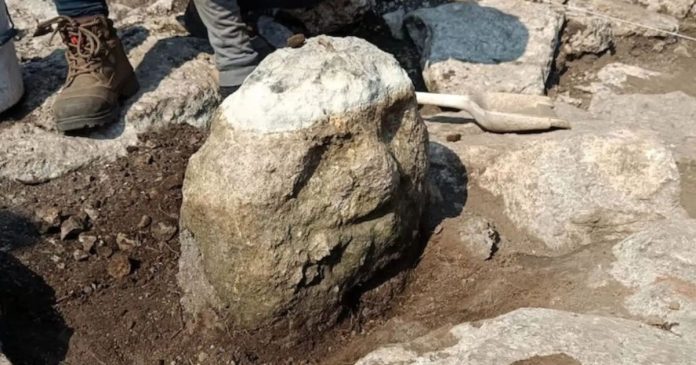The Sculpture and Its Setting
The groove around the mouth highlights the chin. These details show the artisan’s precision and the sculpture’s symbolic purpose.
Archaeologists found the sculpture attached to the northern foundation wall of an oval-shaped structure made with perishable materials. Builders used dressed limestone blocks to form a double wall about one metre thick. The structure measured roughly 5.8 metres long, 4.3 metres wide, and 0.6 metres high. The sculpture’s placement behind the north jamb of the entrance suggests it served as a guardian marker, not simple decoration.
Architectural & Ritual Significance
The entrance to the compound is on its western side, a placement likely chosen to catch the trajectory of sunlight. The doorway is 0.8 metres wide and flanked by two large limestone jambs. Inside, the chamber spans about 3 metres north-south and 2.5 metres east-west.
The thick wall suggests an interior bench may have encircled the space—indicating communal or ritual gathering, rather than domestic use. The sculpture’s guardian role reinforces this interpretation.
Chronology and Function
Current assessments place the structure and the sculpture in the early Preclassic period of the Maya, between roughly 1000 BCE and 200 AD.
Ceramic fragments recovered in the same context point to multiple phases of construction and occupation, evidencing long-term development of the site.
Because the space is small, carefully oriented, and richly built yet modest in scale, researchers believe the Maya reserved it for elite gatherings—ritual, political, or social—rather than for daily domestic life.

What This Discovery Reveals About Maya Society
This discovery shows how early Maya communities in Yucatán designed their buildings to express social rank and control ritual access. The guardian figure symbolises restricted access, signalling that certain spaces were reserved for a specific group or function.
Moreover, the site lies within 2 km of previously recorded structures (Papacal 1 and San Francisco 1) identified by the Costa Maya project—suggesting the region supported a complex and evolving settlement network long before the Classic Maya florescence.
For more discoveries like this check out : Mayan Female Ruler Identified: A Rarity

